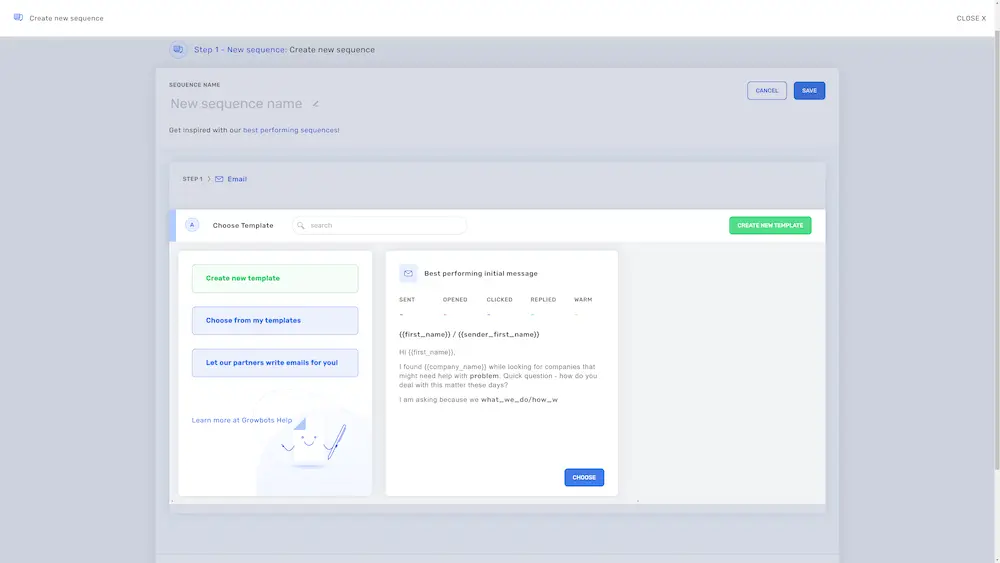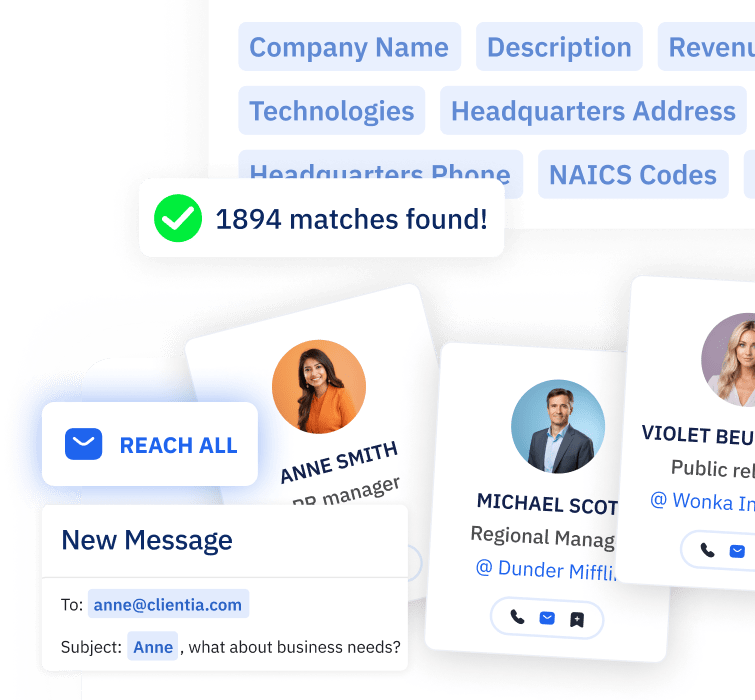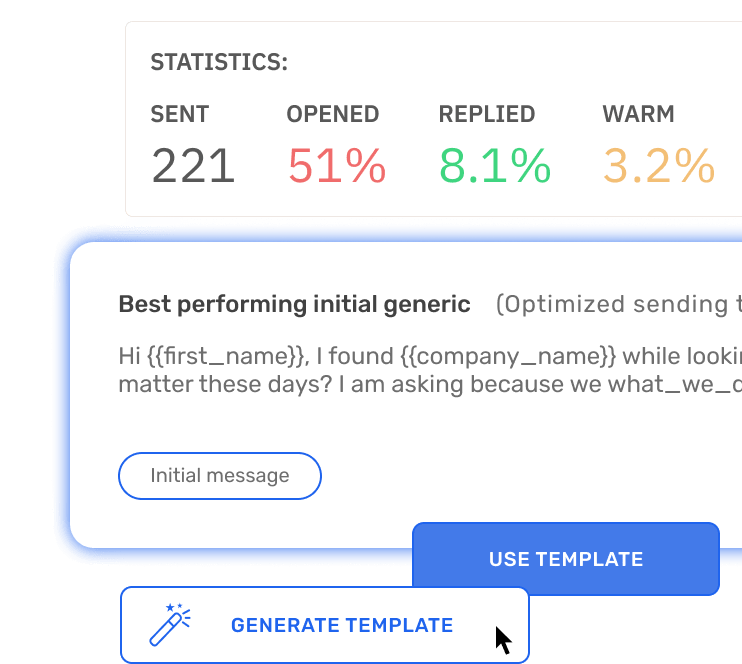Cold email or cold call? Choosing between these tried-and-true methods of reaching out to potential customers you haven’t had any prior contact with can be challenging.
While both approaches have enormous potential for lead generation, selecting the right strategy should be based on your specific goals and target audience. Stay with us if you’re looking to solve a cold call vs. cold email dilemma.
In this guide, we’re exploring these two cold outreach strategies, focusing on their advantages and challenges and providing valuable insights to help you make an informed decision tailored to your business objectives.
So let’s delve in.
TL;DR
- Choosing between cold calling and cold emailing depends on specific goals and target audience.
- Cold calling involves phone contact by sales reps for personalized touch.
- Cold emailing is cost-effective and scalable, but spam and inbox placement challenges exist.
- Both methods have pros and cons; consider factors like response rates, feedback, human connection, and learning about prospects.
- Cold calling pros: higher response rates, immediate feedback, human connection, learning about prospects.
- Cold calling cons: potential intrusion, time-consuming, expensive to scale, legal considerations.
- Cold emailing pros: cost and time efficiency, easy analysis, broad audience reach, brand awareness, automation.
- Cold emailing cons: lack of instant feedback, technical issues, competition, legal considerations.
- Factors to consider when choosing: time/day, outreach goal, prospect expertise, buyer persona, deal progress.
- Combining cold calls and emails creates an efficient strategy catering to different preferences.
- Cold outreach tools like Growbots streamline the outbound sales process and offer insightful analytics. Start a free trial and discover the possibilities of Growbots yourself.
leave no lead unexplored
Every potential client within reach
- 180m+ contacts
- CRM integrations
- 23 Prospect filters
- 15 Company filters
Cold call
Cold calling involves a sales rep contacting prospects by phone to introduce the company’s products or services.
Cold calling is particularly effective when targeting a specific demographic or when it’s crucial to incorporate a personalized touch.
Sales reps making such a phone call commonly use scripts to help them navigate hesitations or objections.
Cold emailing
Cold emailing refers to reaching out to potential clients via email. This outreach method is gaining enormous popularity due to its cost-effectiveness and scalability.
Cold emailing allows businesses to provide a well-thought-out message recipients can review at their convenience while avoiding potential interruptions associated with cold calls.
However, with the growth of spam and unsolicited messages, ensuring your emails get into inboxes might take time and effort.
This is where cold email software can help you automate your workflows, suggest improvements, and ensure that your sales emails land in the right folder.
Read also: Inbound vs outbound sales – what’s the difference and how to connect them both
Is a cold email better than a cold call?
As already mentioned, both methods work. Both emailing and calling prospects help effectively deliver information about your product or service, communicate potential deals, and establish relationships.
Still, cold calls and emails come with pros and cons you should consider when working out your outreach strategy.
Pros of cold calls
1. Potentially higher response rates
Let’s face it: emails are more likely to be unnoticed by your potential customers than phone calls — it’s hard not to notice a ringing or vibrating phone.
2. Immediate feedback
Cold calling allows you to get instant feedback from an individual you’re talking to, which can be different with email outreach. Getting immediate feedback helps you devise your next steps or adjust your overall strategy.
3. A more human connection
While it’s impossible to “feel” a person on the other end of an email, it’s way easier to establish a connection when hearing their voice and identifying their emotions.
4. An opportunity to learn more about your prospects
Communicating with your prospects by phone lets you learn more about their needs, discover pain points you might not have known, and get other valuable information you can use to improve your existing products or services.
Cons of cold calls
1. Some people can find them intrusive
There are people who hate getting an unexpected phone call and listening to an unsolicited sales pitch, so you risk alienating them when cold calling.
When they’re too busy to talk, people often say they’re not interested or just don’t pick up the phone, resulting in a sales representative losing a prospect.
2. It's time-consuming
Another drawback of cold calling is that this method is much more time-intensive than cold email. While you can send thousands of personalized messages in a couple of clicks, a single cold call can take up to 10 minutes or even more, with no guaranteed results.
3. Cold calling is more expensive to scale
While scaling your email marketing efforts requires expanding your email list and investing in email automation software, things are tougher with cold calling. You’ll need to hire more sales reps, meaning higher costs.
4. Legal considerations
Cold calling is subject to various telemarketing and privacy laws. Calling people who are on “Do Not Call” lists or at inappropriate times can result in legal consequences.
Pros of cold emails
1. Time and cost-effectiveness
Sending emails is more cost-effective than cold calling, resulting in higher return on investment. In addition, it requires less time and effort.
2. Easy to analyze
With insightful metrics such as open rates, email campaigns are easier to analyze, allowing you to effectively identify cold email mistakes and adjust your strategy for better results. Moreover, you can test different content, subject lines, and schedules to determine which resonate best with your audience.
3. Reaching a broader audience
The number of people you reach out to with emails depends on the size of your email list rather than your sales rep’s working hours. So, if you focus on reaching as many prospects as possible, email can be a better fit for you.
4. Growing brand awareness
Even if your prospect just scans your email, your brand’s name will ring a bell to them the next time they hear it. Since email marketing campaigns are highly targeted, building brand awareness is inevitable without your prospects realizing it.
5. They can be automated
The most beautiful thing about cold emails is that they can be automated. Among other valuable functions, email software allows you to schedule emails, send personalized messages, and provide insights on improving your campaigns by analyzing key metrics.
Cons of cold emails
1. No instant feedback
Unlike phone conversations, you shouldn’t expect immediate responses to your cold emails. Moreover, you can receive no response from a particular recipient at all.
2. Technical issues
Technical aspects such as bounce rates, email deliverability, and spam complaints may negatively affect your campaign results.
3. Intense competition
Get this: the prospect you are trying to reach gets dozens of emails daily since today’s business competition is more intense than ever.
To stand out, you should craft a sales email to grab your prospect’s attention, demonstrating how your product or service can help solve their pain points. Want to know more? Check out our How to write cold email guide.
4. Legal considerations
Is cold emailing illegal? No, but it’s crucial to follow some rules. Firstly, you must obtain express or inferred consent from the recipient and provide a convenient opt-out method. Next, the subject line of your sales email should reflect the content of the message. Finally, ensure your message contains accurate sender information, including your physical address.
Read also: Best sales books for SaaS businesses you must read
Seek, pick, and reach
Connect with your potential customers
- 180m+ contacts
- Advanced filtering
- Multichannel sequences
- CRM integrations
Cold email vs. cold call: which sales strategy to choose?
While cold calling and cold emails have distinctive advantages and disadvantages, the cold outreach method to best match your audience should be based on the following factors:
Time and day of the week
People become more likely to pick up the phone closer to the end of the week. Speaking of the exact time, the later into the day, the higher the response rate, meaning that sales calls happening around 3-4pm have higher chances of success.
However, the best time to send cold email is from 8 to 12am. on Tuesdays, Wednesdays, or Thursdays. Remember that your prospects may be located across different time zones, so consider it when scheduling your campaign.
The goal of the outreach
Your goal has much to do with choosing between call or email. If you expect immediate commitment from your lead, let’s say, asking for a product trial, cold calling should be your way to go. On the other hand, when the goal of your cold emailing campaign has a different purpose, for instance, collecting feedback, cold emails will suffice.
The prospect's expertise
If you’re focusing on decision-makers, choose cold calling. C-level executives typically have assistants, meaning they have more time for talking on the phone.
The buyer persona
It’s safe to say that the preferred communication method differs across industries and demographics. For example, people whose job involves communicating with customers generally don’t mind receiving phone calls, while millennials are more into emails. Given that, it’s vital to thoroughly analyze your audience when deciding on the best cold outreach method.
The deal's progress
Finally, you can look at the deal’s progress to select an appropriate way to contact your prospect. If everything is going rapidly and your potential customer looks ready to close, a quick email is a great choice. Conversely, calling your prospect may be a faster way to turn them into a lead if they’re unresponsive.
Read also: 5 Reasons To Use Sales Outreach Tools + List of Best to Use
The combined power of cold calls and cold emails
There’s no winner in the cold calling vs. cold emailing battle, and there’s no definitive answer to the question Is it better to cold call or email? Instead, you can have the best of both worlds by combining the two.
Cold calls offer real-time interaction and immediate feedback, allowing you to address questions and objections and build rapport on the spot. On the other hand, cold emails provide the advantage of carefully crafted messages, enabling you to deliver comprehensive information and engage recipients at their convenience.
By strategically combining cold emails and cold calls, you can create a highly efficient outreach strategy that caters to different communication preferences, increasing your chances of capturing the attention of potential clients.
Cold outreach tools
Luckily, there are many sales outreach tools that streamline the sales process, allowing a sales team to focus on more critical tasks. Meet Growbots — an effective tool packed with useful features:
- Accelerating workflows: Growbots lets you create automated sequences, follow-ups, and personalized messages in a matter of minutes.

- Enhancing email deliverability: our tool helps ensure that your message doesn’t land in the spam folder or is banned.

- Automating outreach campaigns: our software allows you to build email sequences using pre-built templates, employing the power of mail merge to personalize your messaging with custom fields.

- Replying to your prospects directly from Growbots: the Shared Inbox feature enables users to reply to all the responses using a single interface.
- Multiple accounts: you can connect all your email accounts to Growbots and manage all your cold emailing campaigns from one place. Moreover, our tool can distribute your outreach emails between your accounts to avoid exceeding your daily limits, maintaining high deliverability.

- Importing your contact lists: besides using our 180M+ database, you can also import your existing mail lists to Growbots. Our tool will automatically verify your contacts to ensure a low bounce rate and high deliverability.

- Creating multi-channel sequences: Growbots allows you to add custom tasks such as calls or LinkedIn outreach to your sequence.

- Easy campaign management: our tool boasts a user-friendly dashboard to help you easily track your cold email campaigns.
- Email tracking and actionable insights: Growbots lets you effectively monitor your emails, helping you identify what works best. Detailed reports, insights, and the A/B testing feature are also included.

- Auto unsubscribing prospects: Growbots automatically unsubscribes a prospect if they request to be removed from your list.
Reach More with Less Effort
Connect with Potential Clients at scale
- AI message generator
- E-mail verification
- Multichannel sequences
- A/B testing
Conclusions
Choosing between cold calling vs. cold emailing should be anchored in your business goals and target audience. However, it’s best to combine them to maximize your cold outreach efforts. Growbots can help you streamline your sales process.
With features like automated sequences, enhanced email deliverability, and detailed reporting, our tool can improve your chances of success.

























